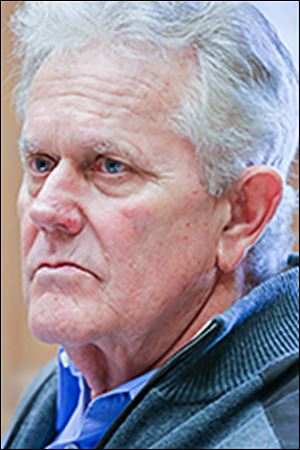
EDITORIAL
Policing heroin
A unique drug treatment initiative would push local law enforcement agencies into a helpful new role
5/16/2014
Tharp
Even the most ardent law enforcement officers acknowledge the importance of treatment and education in alleviating Ohio’s heroin and opioid epidemic. Cops understand that they can’t arrest their way out of a drug problem.
Northwest Ohio residents can take pride that some local law enforcement officials regard getting drug abusers into treatment as part of their jobs. Lucas County Sheriff John Tharp wants to expand that new role with an initiative that county commissioners should approve.
Click here to read more Blade editorials.
Mr. Tharp proposes assigning two full-time sheriff’s deputies to work with families that are dealing with drug overdoses. In nonfatal cases, deputies — perhaps in plain clothes — would try to get overdose victims into local treatment programs, after meeting their families at hospitals and conducting follow-up interviews.
The deputies would have a dual role: Aside from making treatment referrals, they would try to get anonymous information about who sold the drugs, and then work with the Metro Drug Task Force to investigate dealers. Depending on their caseload, the deputies could also be available for other duties.
The yearlong pilot program could cost up to $185,000. Mr. Tharp, who oversees an annual budget of about $28 million, is asking the county Board of Commissioners for its approval.
“We can’t sit back and wait three or four months for a grant, when we have a chance to save lives now,” the sheriff told The Blade’s editorial page.
Mr. Tharp also said he wants to set up, possibly with the United Way of Greater Toledo, a heroin call line that would not only receive anonymous tips about who’s selling drugs, but also answer requests from people who are looking for drug treatment, either for themselves or for family members or friends.
Two months ago, local law enforcement agencies started planning how they could work with the Lucas County Prosecutor’s Office, the county coroner, the state Bureau of Criminal Investigation, and other agencies to get overdose victims into treatment and pursue and arrest drug dealers.
Local 911 dispatchers are now notifying the Sheriff’s Department of every drug overdose. But getting the right deputy to the hospital is important.
By assigning deputies to the project full-time, the sheriff could better ensure that officers who work with families have the personal skills and training to gain their trust and help them. The program can’t work if it seeks to arrest overdose victims with small quantities of drugs.
“We need to build strong relationships with the community,” Mr. Tharp said. “We want to do all that we can to make sure people don’t overdose again, because the next time could be fatal.”
Last year, heroin killed nearly 100 Toledo-area people, while wrecking the lives of thousands more. More than 10,000 people in the region are addicted to prescription painkillers and heroin.
They risk an overdose every time they use illicit drugs. Even over-the-counter medication can fatally interact with heroin, as addicts ingest different combinations of drugs, as well as illicit drugs of varying levels of purity, without understanding the consequences.
Creative initiatives can put law enforcement in a new role in fighting northwest Ohio’s opioid epidemic. Interdiction alone won’t solve the problem.
Reducing demand for the drugs, while saving lives, is the most effective strategy. Getting law enforcement more involved in treating addiction is one way to do it.